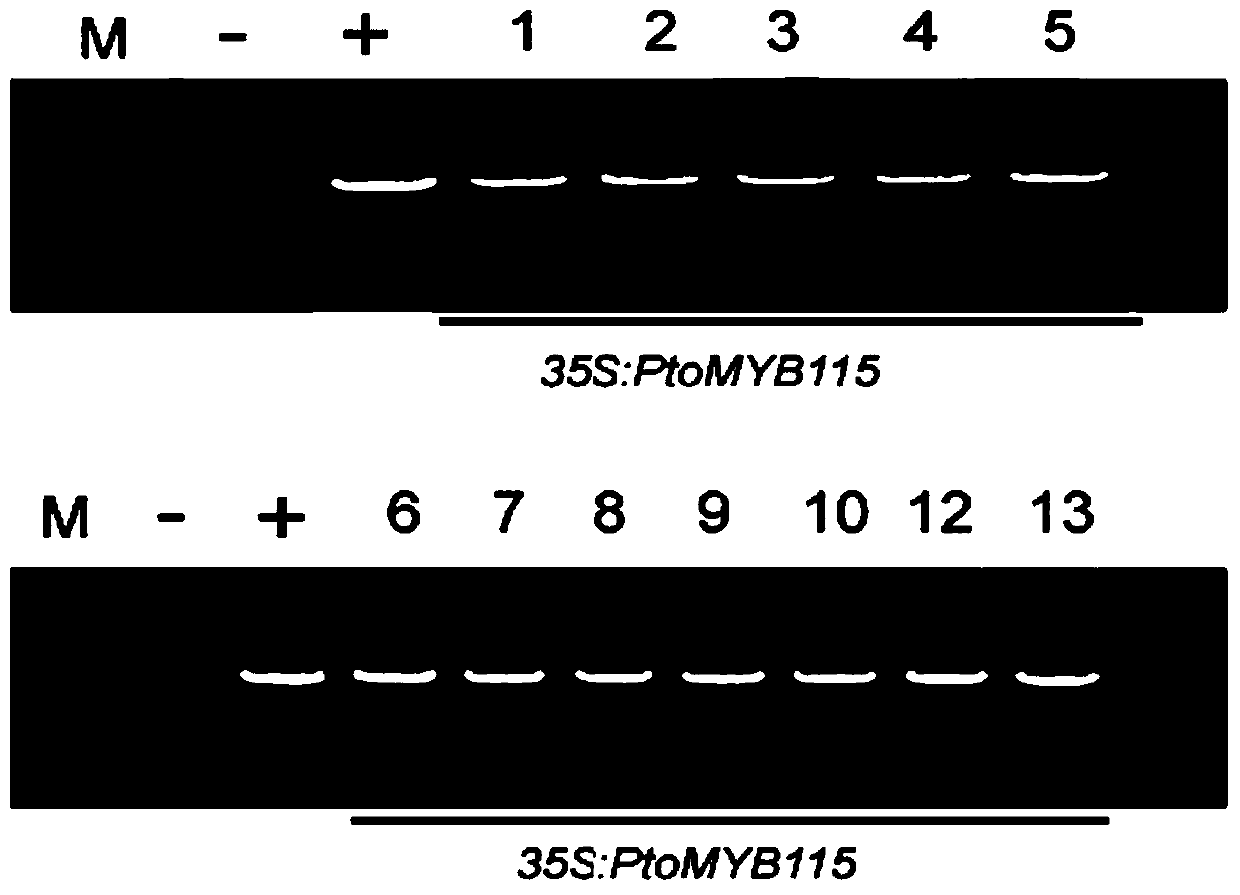Transcription factor ptomyb115 specifically regulating tannin synthesis and its use
A technology of transcription factor and expression vector, applied in application, genetic engineering, plant genetic improvement and other directions, can solve the problems of poplar susceptible to diseases and insect pests, difficult to consolidate engineering achievements, failure, etc., to improve the ability of canker disease and improve disease resistance. Effect
- Summary
- Abstract
- Description
- Claims
- Application Information
AI Technical Summary
Problems solved by technology
Method used
Image
Examples
Embodiment 1
[0031] Example 1 Poplar total RNA extraction and reverse transcription synthesis of cDNA
[0032] 1. Poplar total RNA extraction
[0033]The young leaves of poplar were used as materials, and the medicine spoons, pestles and mortars used in RNA extraction were all burned with 95% alcohol until cooled before use. Take a spoonful of quartz sand and heat it in a heater for 10 minutes to cool it before use. 1.5mL centrifuge tubes, plastic products, etc. use RNase-treated (RNase Free) AXYGEN products.
[0034] Total RNA extraction was performed according to the operation steps of Huashun Server-SPIN DNA-free Plant RNA Isolation Kit:
[0035] 1) Add lysate (500 μL RL+100 μL 10% PVP+10 μL 2-ME) to a 1.5 mL centrifuge tube;
[0036] 2) Mix young poplar leaves (100mg) and quartz sand under liquid nitrogen freezing conditions and quickly grind them into powder. Before the liquid nitrogen is completely volatilized, transfer all the powder to the pre-prepared lysis solution, and pipett...
Embodiment 2
[0051] Example 2 Design of PCR primers and PCR amplification to obtain target fragments
[0052] 1. PCR primer design
[0053] Log on to PHYTOZOME (http: / / www.phytozome.com) to find the CDS sequence of the PtrMYB115 gene of P. tomentosa. According to the sequence, the specific primer of PtoMYB115CDS of Populus tomentosa was designed. The upstream primer PtoMYB115-F sequence of the PtoMYB115 fragment is: 5 '-ATGGGAAGGGCTCCTTGTTG-3' (SEQ ID No. 4), downstream primer PtoMYB115-R sequence: 5'-TTGTCATACCAGCAGTGACT-3' (SEQ ID No. 5); target fragment 858bp.
[0054] Primers were synthesized by BGI (Beijing). The reaction reagents used in PCR are all products of TaKaRa company: dNTP Mixture (2.5mM each), Taq DNA polymerase (5U / μL), with 10×PCR Buffer (0.1M Tris-HCl [pH8.3]), 0.5M KCl) and MgCl 2 (25mM).
[0055] 2. PCR amplification of the target fragment
[0056] The PtoMYB115 gene fragment was amplified using poplar cDNA as a template, and the system for amplifying the PtoMYB11...
Embodiment 335
[0068] Example 335S: PtoMYB115 vector construction and transformation of Agrobacterium EHA105
[0069] After the amplified fragment gel was recovered, the carrier pCXSN (provided by Professor Wang Guoliang of South China Agricultural University) was digested with XcmI and then connected with the recovered fragment to obtain 35S:PtoMYB115 carrier (sequence shown in SEQ ID No. 3). The map is shown in figure 1 . The ligation product was transformed into Escherichia coli DH5α competent cells, and the target gene fragment was amplified by PCR and verified by enzyme digestion to obtain transformants, and the strains were stored.
[0070] The 35S:PtoMYB115 plasmid was extracted from the positive transformant Escherichia coli respectively, and the steps were in accordance with the extraction steps of the PlasmidMini Kit. The specific operations are as follows:
[0071] ① Take the bacterial liquid cultured to the logarithmic phase in an EP tube, centrifuge at 13400 rpm for 1 min to co...
PUM
 Login to View More
Login to View More Abstract
Description
Claims
Application Information
 Login to View More
Login to View More - R&D
- Intellectual Property
- Life Sciences
- Materials
- Tech Scout
- Unparalleled Data Quality
- Higher Quality Content
- 60% Fewer Hallucinations
Browse by: Latest US Patents, China's latest patents, Technical Efficacy Thesaurus, Application Domain, Technology Topic, Popular Technical Reports.
© 2025 PatSnap. All rights reserved.Legal|Privacy policy|Modern Slavery Act Transparency Statement|Sitemap|About US| Contact US: help@patsnap.com



